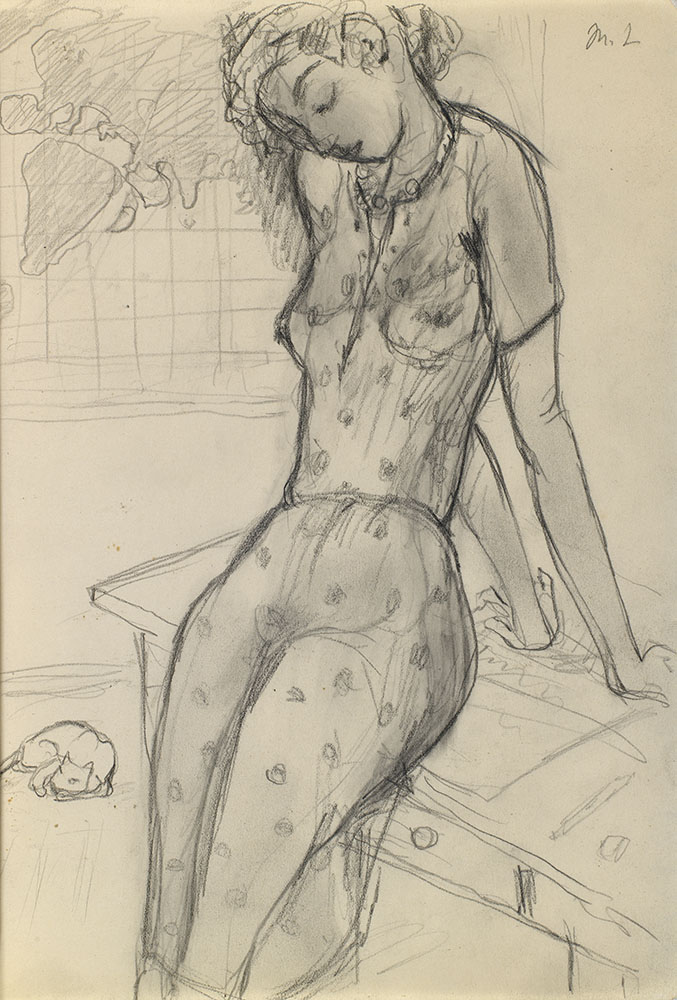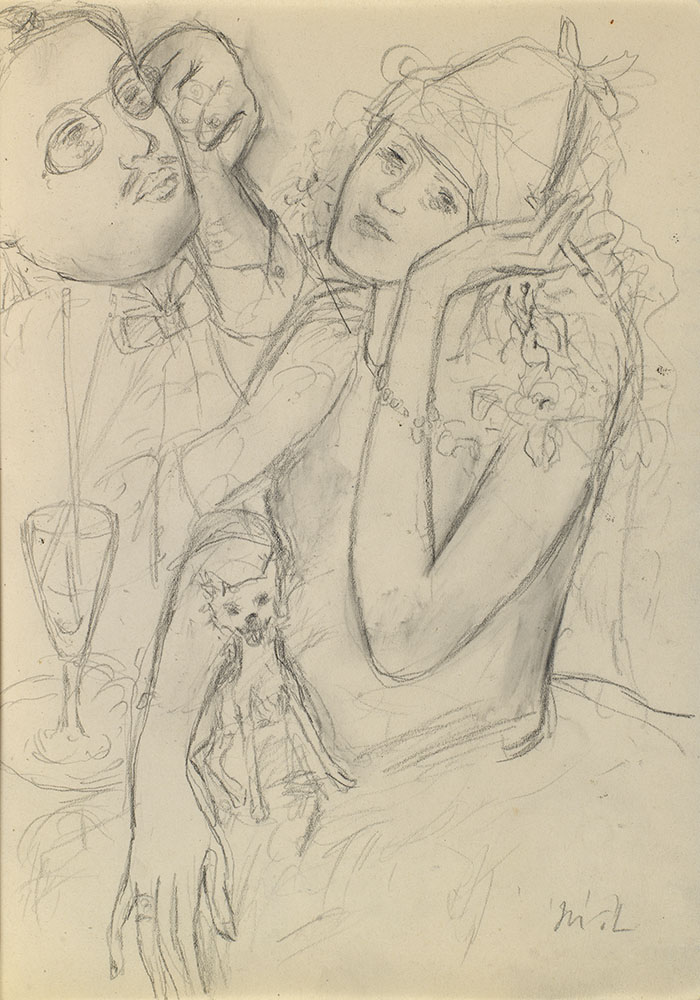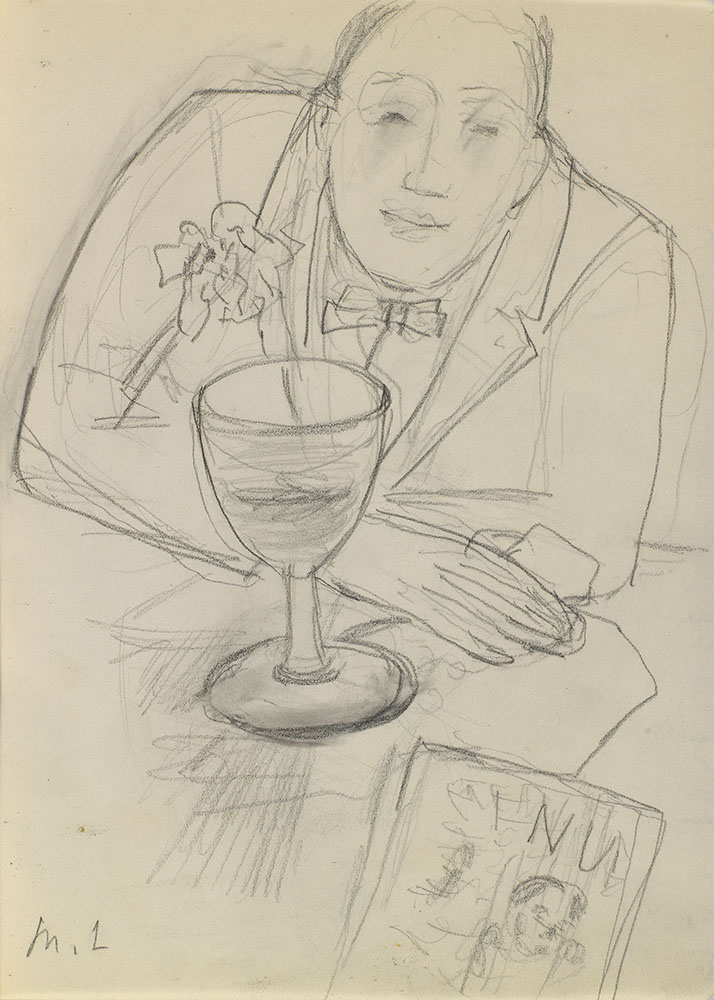3 June 2015 Russian Art Auctions
3 June 2015

§ 17. LARIONOV, MIKHAIL (1881-1964)
Sketchbook with Drawings, 67 works, 41 signed, one inscribed in Cyrillic and one double-sided.
Each pencil on paper, one measuring 21 by 13.5 cm and the others 27.5 by 20.5 cm.
150,000-200,000 GBP
Executed in the 1920s.
Provenance: A gift from the artist to Irina Grzhebina, a ballet dancer and director of the company Russian Ballet of Irina Grzhebina, Paris, 1940s.
A gift from the above to A. Kovalsky, a Soviet diplomat, Paris, 1986.
A gift from the above to the present owner, Moscow, 2007.
Private collection, Austria.
Authenticity of the work has been confirmed by the expert G. Pospelov.
Literature: L. Pospelov, "Moi vstrechi s Tomilinoi", in Russkoe iskusstvo, No. 1, 2012, pp. 17-19, mentioned in the text.
Sketchbook with Drawings by Mikhail Larionov will be of interest to all those who esteem his work. It dates from the early part of the artist’s French period, the 1920s. It is hard to be more precise, since the genre pieces and nudes which fill the book were characteristic of the artist’s work throughout that decade.
The album most probably dates from Larionov’s first years in Paris, as suggested by its vivid impressions of ordinary life in the French capital: people on the streets, in theatre seats, at café tables, an elderly woman with the Eiffel tower in the background. Details which would have become too familiar after many years spent in the city.
This freshness is equally apparent in the album’s drawings of the model. Larionov’s representations of a female figure at home in a petticoat, or naked, washing herself in a bowl, are reminiscent of Degas. Larionov did not use a professional model. The subject of these drawings is Alexandra (affectionately “Shura”) Tomilina, with whom the artist began a liaison at the start of the 1920s. She was a Russian emigrée, the daughter of the
Moscow banker Klavdy Tomilin, and she had an apartment where Larionov lived at No.16 Rue Jacques Callot. Tomilina’s figure en face on one of the album sheets might serve as frontispiece for the whole book. The artist never tired of drawing her, and these images were familiar to a wide circle of his contemporaries. Larionov “draws in yellowish paint a yellowish woman with yellowish hair and low hips,” Nina Berberova wrote in her memoirs, straight to the point, as was her custom.
But Larionov’s approach in these works is far from Berberova’s matter-of-factness.
He looks at his model from the viewpoint of an artist who is also a man in love. Larionov at the time was over forty whilst Tomilina was a little over twenty and he is evidently entranced by her movements and postures, and bewitched by the naturalness of her young being. In one picture, she lies tranquil, post coitus, her body draped over cushions, in another she washes herself by the bed, reaching for a towel (bathrooms did not become widespread in the old houses of the Latin Quarter until much later). Larionov was full of enthusiasm for life in all its manifestations, from the movements of a woman washing herself to those of a lap dog, scratching itself behind the ear (these dogs recur throughout his work and the present album is no exception). The artist captures the plasticity of the female body with the same interest and accuracy as he might capture the movements of an animal.
But Larionov also conveys the captivating grace of his young subject, and many of the pages are suffused with emotional warmth. After his break-up with Natalia Goncharova, Larionov spent many years with Tomilina, who remained his “guardian angel” until the end of his life. One of the pages shows a female figure in a tired pose, wearing nothing but a transparent dress, and the soft pencil of the draftsman literally caresses her outline;
the descending line of her waist and hips and the contours of her arm, leaning against the table. Such feeling is no longer visible in Larionov’s drawings from the second half of the 1920s.
These sketches were the starting point for more sophisticated works, many of them now famous, such as the Standing Nude with Arms Raised from the collection of the State Tretyakov Gallery in Moscow (the model is indisputably Tomilina). One of the album pages is the source of the 1920s series of recumbent nudes. Another sketch (Woman at the Hairdresser) gave rise to a number of excellent drawings that share the theme of Larionov’s painting Prostitute at the Hairdresser (the State Tretyakov Gallery), which is usually dated to the end of the 1920s, but judging from the present album, is more likely to have been created at the beginning of that decade.
Many other ideas never went beyond the covers of the album, where Larionov experiments with possible themes for new paintings. Slender Shura is represented as a café waitress, her arms drooping in exhaustion beside rows of as yet unopened bottles, as a girl in a brothel, or side-by side with the severe figure of a nun. Seeking a place in the French art tradition (particularly that of Renoir and Manet), Larionov tried theatrical subjects, where Shura is transformed into an elegant lady in a fashionable hat
and with a fan, accompanied by a gentleman with a monocle who is immediately
identifiable as Sergei Diaghilev.
Of course, the album now presented was not alone of its kind. Larionov’s albums succeeded one another as a substratum beneath his principal artistic output. Although Larionov was never parted from his albums, he attached little importance to them, treating them as raw material for his paintings and drawings.
Today, these albums acquire an importance far beyond what they meant to have Larionov’s lifetime. The artist’s fame and esteem in which he is held, have increased steadily over the years. Critics and the art audience of today are interested in the entirety of Larionov’s output – and not merely in his central works. His life sketches are brimful of the excitement of lived experience. As we have demonstrated, they are also masterworks of Larionov’s graphic art.
Dr Gleb Pospelov, art historian



Notes on symbols:
* Indicates 5% Import Duty Charge applies.
Ω Indicates 20% Import Duty Charge applies.
§ Indicates Artist's Resale Right applies.
† Indicates Standard VAT scheme applies, and the rate of 20% VAT will be charged on both hammer price and premium.